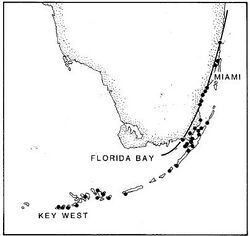Biology:Mangrove gambusia
| Mangrove gambusia | |
|---|---|
| Scientific classification | |
| Domain: | Eukaryota |
| Kingdom: | Animalia |
| Phylum: | Chordata |
| Class: | Actinopterygii |
| Order: | Cyprinodontiformes |
| Family: | Poeciliidae |
| Genus: | Gambusia |
| Species: | G. rhizophorae
|
| Binomial name | |
| Gambusia rhizophorae Rivas, 1969
| |
The Mangrove gambusia (Gambusia rhizophorae) is a tropical poeciliid (live bearing) fish species with a restricted, disjunct range one in northwestern Cuba, the other in southeastern Florida.[3] The Florida population has been recently listed as "biologically vulnerable" (vulnerable to extinction because of the taxon’s biology or other indicators) by the Florida Fish and Wildlife Conservation Commission.
Species description
The Mangrove gambusia is a brackish fish, typically a resident of sheltered mangrove forests. In Florida, the species is distributed from Fort Lauderdale, south along the mainland coast, and throughout the Florida Keys to Key West. Its distribution in Florida appears to be temperature limited (Getter, 1982). The exact location of the Cuban population is being examined to allow a map of its distribution to be produced.
Conservation
Habitat destruction for development has reduced available habitats through loss of a number of mangrove forests and formerly occupied sites (Charles Getter, 1976) in Florida. Also contributing to biological vulnerability is the species' limited habitat, temperature restrictions, and hybridization with other species throughout its range (Charles Getter, 1976). One of the largest populations known for the Mangrove gambusia was the lush 100+ acre mangrove forest known as the "Cocoplum Islands" that was developed into the Cocoplum Development in the mid-1970s.
Biology and life history
Ongoing research is underway by Dr. Charles Getter, who has studied the species since the 1970s.
References
- ↑ Vega-Cendejas, M.; Espinosa-Perez, H.; Tolan, J.; Collette, B.B.; Jelks, H.; Chao, L. (2020). "Gambusia rhizophorae". IUCN Red List of Threatened Species 2020: e.T46103983A185166576. doi:10.2305/IUCN.UK.2020-3.RLTS.T46103983A185166576.en. https://www.iucnredlist.org/species/46103983/185166576. Retrieved 20 November 2021.
- ↑ "Gambusia rhizophorae - Rivas, 1969". http://explorer.natureserve.org/servlet/NatureServe?searchName=Gambusia+rhizophorae.
- ↑ Froese, Rainer and Pauly, Daniel, eds. (2019). "Gambusia rhizophorae" in FishBase. August 2019 version.
- Charles Getter. 1976. The systematics and biology of the poeciliid fish, Gambusia rhizophorae with an account of its hybridization with Gambusia affinis and Gambusia punctata. Master's Thesis. University of Miami, 258 pages.
- Florida Fish and Wildlife Conservation Commission. 2005. Species of greatest conservation need.
- Charles Getter, 1982. Temperature limitations to the distribution of mangrove mosquitofish in Florida. Florida Scientist 45(3):196-200.
- "Natural and Anthropogenic Events Impacting Florida Bay 1910 - 1994 Time Line". NOAA. Archived from the original on March 9, 2013. https://web.archive.org/web/20130309085734/http://ccma.nos.noaa.gov/stressors/pollution/bioeffects/pdf/tm90_FL%20Bay.pdf.
 This article incorporates text from this source, which is in the public domain.
This article incorporates text from this source, which is in the public domain.
Wikidata ☰ Q3753321 entry
 |





